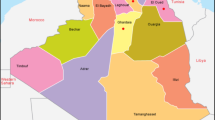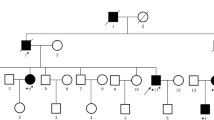Abstract
Purpose
Familial adenomatous polyposis is characterized by the development of hundreds of adenomatous polyps located mainly in the colon and rectum. Patients with familial adenomatous polyposis who do not receive treatment will develop cancer before aged 40 years. This disease is caused by germline mutations in the adenomatous polyposis coli gene. Different studies have shown a correlation between the location of the mutation and the clinical phenotype, such as the grade of severity and/or the presence of extracolonic manifestations, such as desmoid tumors. This study was designed to identify germline mutation in the adenomatous polyposis coli gene in Chilean families with familial adenomatous polyposis.
Methods
We examined the adenomatous polyposis coli gene in 24 Chilean families with familial adenomatous polyposis. The adenomatous polyposis coli gene was screened for mutations combining single strand conformation polymorphism technique, protein truncation test, and DNA sequencing.
Results
We detected 17 different truncating mutations in 21 of 24 families (87.5 percent); 9 of these were novel. Fourteen mutations were detected in exon 15, being the most frequent c.3927_3931delAAAGA, found in 3 of 21 families (14 percent). Eight families (33 percent) showed at least one patient affected with desmoid tumors, presenting mutations between codons 849 and 1533. Interestingly, two mutations, c.3632dupA and c.3783_3784delTT, leading into a truncating protein at codons 1216 and 1274, were associated with almost 100 percent penetrance for desmoid tumors among relatives.
Conclusions
We achieved 87 percent mutation detection rate in adenomatous polyposis coli gene; more than 50 percent of them were novel. The high percentage of novel mutations found may be because of the genetic composition of the Chilean population, which is an admixture of Amerindian and Spaniards, and the scarce information in the literature about similar populations.

Similar content being viewed by others
References
Strate LL, Syngal S. Hereditary colorectal cancer syndromes. Cancer Causes Control 2005;16:201–13.
Leppert M, Dobbs M, Scambler P, et al. The gene for familial polyposis coli maps to the long arm of chromosome 5. Science 1987;238:1411–3.
Nakamura Y, Lathrop M, Leppert M, et al. Localization of the genetic defect in familial adenomatous polyposis within a small region of chromosome 5. Am J Hum Genet 1988;43:638–44.
Kinzler KW, Nilbert MC, Su LK, et al. Identification of FAP locus genes from chromosome 5q21. Science 1991;253:661–5.
Groden J, Thliveris A, Samowitz W, et al. Identification and characterization of the familial adenomatous polyposis coli gene. Cell 1991;66:589–600.
He TC, Sparks AB, Rago C, et al. Identification of c-MYC as a target of the APC pathway. Science 1998;281:1509–12.
Fearnhead NS, Britton MP, Bodmer WF. The ABC of APC. Hum Mol Genet 2001;10:721–33.
Merg A, Lynch HT, Lynch JF, Howe JR. Hereditary colon cancer: part I. Curr Probl Surg 2005;42:195–256.
Galiatsatos P, Foulkes WD. Familial adenomatous polyposis. Am J Gastroenterol 2006;101:385–98.
Nagase H, Miyoshi Y, Horii A, et al. Correlation between the location of germ-line mutations in the APC gene and the number of colorectal polyps in familial adenomatous polyposis patients. Cancer Res 1992;52:4055–7.
Spirio L, Olschwang S, Groden J, et al. Alleles of the APC gene: an attenuated form of familial polyposis. Cell 1993;75:951–7.
Friedl W, Meuschel S, Caspari R, et al. Attenuated familial adenomatous polyposis due to a mutation in the 3’ part of the APC gene. A clue for understanding the function of the APC protein. Hum Genet 1996;97:579–84.
Caspari R, Olschwang S, Friedl W, et al. Familial adenomatous polyposis: desmoid tumors and lack of ophthalmic lesions (CHRPE) associated with APC mutations beyond codon 1444. Hum Mol Genet 1995;4:337–40.
Bisgaard ML, Bulow S. Familial adenomatous polyposis (FAP): genotype correlation to FAP phenotype with osteomas and sebaceous cysts. Am J Med Genet A 2006;140:200–4.
Bertario L, Russo A, Sala P, et al. Hereditary Colorectal Tumor Registry. Multiple approach to the exploration of genotype-phenotype correlations in familial adenomatous polyposis. J Clin Oncol 2003;21:1698–707.
Caspari R, Friedl W, Mandl M, et al. Familial adenomatous polyposis: mutation at codon 1309 and early onset of colon cancer. Lancet 1994;343:629–32.
Donoso A, Villarroel L, Pinedo G. Aumento de la mortalidad por cáncer de colon en Chile, 1990–2003. Rev Med Chil 2006;134:152–8.
Lahiri DK, Nurnberger JI Jr. A rapid non-enzymatic method for the preparation of HMW DNA from blood for RFLP studies. Nucleic Acids Res 1991;19:5444.
Miyoshi Y, Ando H, Nagase H, et al. Germ-line mutations of the APC gene in 53 familial adenomatous polyposis patients. Proc Natl Acad Sci USA 1992;89:4452–6.
van der Luijt R, Khan PM, Vasen H, et al. Rapid detection of translation-terminating mutations at the adenomatous polyposis coli (APC) gene by direct protein truncation test. Genomics 1994;20:1–4.
Cifuentes L, Valenzuela C, Cruz-Coke R, Armanet L, Lyng C, Harb Z. Genetic characterization of the hospital population of Santiago, Chile. Rev Med Chil 1988;116:28–33.
Rocco P, Morales C, Moraga M, et al. Genetic composition of the Chilean population. Analysis of mitochondrial DNA polymorphism. Rev Med Chil 2002;130:125–31.
De Rosa M, Dourisboure RJ, Morelli G, et al. First genotype characterization of Argentinean FAP patients: identification of 14 novel APC mutations. Hum Mutat 2004;23:523–4.
Resta N, Stella A, Susca F, et al. Nine novel APC mutations in Italian FAP patients. Hum Mutat 2001;17:434–5.
Ruiz-Ponte C, Vega A, Carracedo A, Barros F. Mutation analysis of the adenomatous polyposis coli (APC) gene in northwest Spanish patients with familial adenomatous polyposis (FAP) and sporadic colorectal cancer. Hum Mutat 2001;18:355.
Kim DW, Kim IJ, Kang HC, et al. Mutation spectrum of the APC gene in 83 Korean FAP families. Hum Mutat 2005;26:281.
Laken SJ, Petersen GM, Gruber SB, et al. Familial colorectal cancer in Ashkenazim due to a hypermutable tract in APC. Nat Genet 1997;17:79–83.
Gryfe R, Di Nicola N, Lal G, Gallinger S, Redston M. Inherited colorectal polyposis and cancer risk of the APC I1307K polymorphism. Am J Hum Genet 1999;64:378–84.
Syngal S, Schrag D, Falchuk M, et al. Phenotypic characteristics associated with the APC gene I1307K mutation in Ashkenazi Jewish patients with colorectal polyps. JAMA 2000;284:857–60.
Stern HS, Viertelhausen S, Hunter AG, et al. APC I1307K increases risk of transition from polyp to colorectal carcinoma in Ashkenazi Jews. Gastroenterology 2001;120:392–400.
Woodage T, King SM, Wacholder S, et al. The APCI1307K allele and cancer risk in a community-based study of Ashkenazi Jews. Nat Genet 1998;20:62–5.
Cowie S, Drmanac S, Swanson D, et al. Identification of APC gene mutations in colorectal cancer using universal microarray-based combinatorial sequencing-by-hybridization. Hum Mutat 2004;24:261–71.
Rask K, Nilsson A, Brannstrom M, et al. Wnt-signalling pathway in ovarian epithelial tumors: increased expression of beta-catenin and GSK3beta. Br J Cancer 2003;89:1298–304.
Arvanitis ML, Jagelman DG, Fazio VW, Lavery IC, McGannon E. Mortality in patients with familial adenomatous polyposis. Dis Colon Rectum 1990;33:639–42.
Bertario L, Presciuttini S, Sala P, Rossetti C, Pietroiusti M. Causes of death and postsurgical survival in familial adenomatous polyposis: results from the Italian Registry. Italian Registry of Familial Polyposis Writing Committee. Semin Surg Oncol 1994;10:225–34.
Cetta F, Montalto G, Gori M, Curia MC, Cama A, Olschwang S. Germline mutations of the APC gene in patients with familial adenomatous polyposis-associated thyroid carcinoma: results from a European cooperative study. J Clin Endocrinol Metab 2000;85:286–92.
Michils G, Tejpar S, Fryns JP, et al. Pathogenic mutations and rare variants of the APC gene identified in 75 Belgian patients with familial adenomatous polyposis by fluorescent enzymatic mutation detection (EMD). Eur J Hum Genet 2002;10:505–10.
Michils G, Tejpar S, Thoelen R, et al. Large deletions of the APC gene in 15% of mutation-negative patients with classical polyposis (FAP): a Belgian study. Hum Mutat 2005;25:125–34.
Al-Tassan N, Chmiel NH, Maynard J, et al. Inherited variants of MYH associated with somatic G:C–>T:A mutations in colorectal tumors. Nat Genet 2002;30:227–32.
Sampson JR, Dolwani S, Jones S, et al. Autosomal recessive colorectal adenomatous polyposis due to inherited mutations of MYH. Lancet 2003;362:39–41.
Tamura K, Yamamoto Y, Saeki Y, Furuyama J, Utsunomiya J. Simple, rapid, and accurate determination of deletion mutations by automated DNA sequencing of heteroduplex fragments of the adenomatous polyposis coli (APC) gene generated by PCR amplification. Hum Mutat 1993;2:478–84.
Ripa R, Bisgaard ML, Bulow S, Nielsen FC. De novo mutations in familial adenomatous polyposis (FAP). Eur J Hum Genet 2002;10:631–7.
Bjork J, Akerbrant H, Iselius L, et al. Periampullary adenomas and adenocarcinomas in familial adenomatous polyposis: cumulative risks and APC gene mutations. Gastroenterology 2001;121:1127–35.
Author information
Authors and Affiliations
Corresponding author
Additional information
Supported by the national public grant, Fondecyt #1040827.
Reprints are not available.
About this article
Cite this article
De la Fuente, M.K., Alvarez, K.P., Letelier, A.J. et al. Mutational Screening of the APC Gene in Chilean Families with Familial Adenomatous Polyposis: Nine Novel Truncating Mutations. Dis Colon Rectum 50, 2142–2148 (2007). https://doi.org/10.1007/s10350-007-9044-z
Published:
Issue Date:
DOI: https://doi.org/10.1007/s10350-007-9044-z




